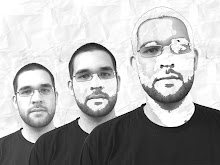Wednesday, November 08, 2006
Who's way around what wall?
-Paulo Freire (Freire, 1972, pg. 62)
Everyday we walk similar physical paths, confined and restricted by locked doors, fences, high walls, security, and most of all our own fears. And everyday we walk similar mental paths, confined and restricted by enslaving conditioning, rules, and again our own fears. As an adult I am controlled by this fear. Can I do this? Can I go there? Would a sane person think that? Is this what I need to do to succeed, to belong? It could be said that as human beings many of us to do not overcome our obstacles, we never realise who we are, we use the word freedom like it’s going out of fashion but we use it only as a word, never a concept. We yell and scream for freedom but never overcome the obstacles that stand in our way. It is art without context. Metaphorically speaking it is cold, hard, and concrete.
However, concrete can be overcome. It can be destroyed. Although we must ask ourselves why destroy the very thing we can learn from? Why destroy something we can use? There is no need for destruction when the act of moving around the concrete is an act of creation; a physical and mental act of freedom.
There are two realms, the obstacles of the mind, and those of the body, they are distinct yet similar. Each realm has its own obstacles, and each obstacle has endless ways around it. In the realm of the mind, I propose, with the support of Freire that education is the way around the confines of a mental nature, however the mind is not isolated from the body, it is attached to the world, it exists, it is real, and as concrete as the physical (Freire, 1972, p.62). Therefore physical movement around any obstacle is education, not the object itself.
When facing these obstacles; be that of the body, or of the mind, there are certain pre-requisites that different options require. To overcome an obstacle of the body many factors limit your choice, but with training and knowledge of your own physical self, you are presented with endless opportunities to engage with and overcome the obstruction. Without this particular ‘knowledge’ there is only a limited range of options. When faced with an obstacle of the mind there are again certain precursors that determine what options are available to you. Education is the act of opening up these options. Not by creating the walls, but by working on the individual. Any one person will face numerous walls in their lives, each one with different context and meaning, the only part that remains constant is the individual. Education should not tell you how to overcome the wall, or which ways to do it, or even if it is possible. Education should give you the skill to critically examine the obstacle to reflect on its severity synthesised with your own ability and potential to reach a personalised way past it.
How do we realise this freedom within the context of schooling and education? A clear definition must be articulated if one can make any sense of this; education as freedom and education as an obstacle. Education as an obstacle works against the notion of freedom. Imagine facing a large wall, education has taught you that you cannot scale the wall, you cannot knock it down, and education would have you believe that the wall has you at its mercy. Education has taught you that there is only one way past the wall, let us say, metaphorically the door at the base. In this example education stands as a barrier to freedom, a barrier to prevent you from imagining a new and personalised way around the wall. It is this imagination, this act of problem solving that lies as the essence of knowledge, as Freire explains, knowledge blossoms only from invention and re-invention, from inquiring relationship between the world and the human being (Freire, 1972, pg.53). It is this removal of the individual from the world that creates the dehumanisation of students and teachers (Freire, 1972, pg.53).
If the purpose of school is to educate, to create life long learners and autonomous individuals then it must practise freedom in order to achieve this goals. If we, as educators, wish to help students develop into free beings, then we must act in such away that promotes and advocates freedom. We are not, and we will never be emancipators, because the students never come to us enslaved. The role of emancipator is patronising at best. Our role is to educate them, so they can set themselves free. At this current historical moment students all over the world are standing at the foot of their own walls. These walls are metaphorical, and physical, they are walls of the mind, and walls of the spirit. Schools build their own walls. They call them curriculum. Schools tell students how to get around the wall, how well the students do this is called assessment. The proof is in the research. Factors such as socio-economic status, gender, sexuality, all have roles to play in engagement of schools. Students from lower socio-economic brackets have less chance of success in schools, and the programs that they offer (Teese, Polesel, 2003, pg. pg.9). Schools are, at times, exclusive places of irrelevant knowledges run by benchmarks of intelligence that do not take into account the individual. This has the effect of ostracising the student from the learning experience. Schools are excluding human beings, or worse still, enslaving them to an imposed knowledge and understanding of the world.
If education is not detached from the physical then the physical cannot be detached from education. Therefore obstacles and walls of the mind are no different to obstacles or walls of the body. To overcome a physical obstacle can be considered a practise of education, a vision of curriculum. Enter the ‘Art of Displacement’(1).
“The art of displacement is a type of freedom; it’s a kind of expression, a trust in you. I don’t think there is a clear definition for it. When you explain it to people, you say: Yes I climb, I jump, and I keep moving! It’s the definition! But no one can understand that. They need to see things. But it’s only a state of mind. It’s when you trust in yourself; you earn energy, a better knowledge of your body, to be able to move, to overcome obstacles in the real world, or in a virtual world”
-Chau Belle-Dinh (Daniels, 2005 [Film])
Yamakasi Founder
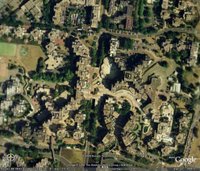 Faced with a bleak concrete environment the inhabitants of Évry, France’s youngest town (the average age is 26 years old), created the Art of Displacement (Daniels, 2005 [Film]). When faced with the biggest obstacles of them all they found their own path: over poverty, around hopelessness, through their fear, and across the concrete jungle that they lived in. it is now, on a quest to find my own curriculum vision that I turn to their philosophy of Yamakasi, meaning ‘strong body, strong spirit, strong person’ (Wikipedia, 2006).
Faced with a bleak concrete environment the inhabitants of Évry, France’s youngest town (the average age is 26 years old), created the Art of Displacement (Daniels, 2005 [Film]). When faced with the biggest obstacles of them all they found their own path: over poverty, around hopelessness, through their fear, and across the concrete jungle that they lived in. it is now, on a quest to find my own curriculum vision that I turn to their philosophy of Yamakasi, meaning ‘strong body, strong spirit, strong person’ (Wikipedia, 2006).(Pic Left) The Home of Yamakasi, Evry, France. Notice the complexity of the architecture, the perfect ingredients for Free-Running
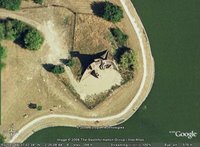 (Pic Right) Dame Du Lac - ths structure was built in the 70s as a climbing structure. It is where the first generation of Yamakasi developed and honed their art form and movement. It is now closed to the public. See also
(Pic Right) Dame Du Lac - ths structure was built in the 70s as a climbing structure. It is where the first generation of Yamakasi developed and honed their art form and movement. It is now closed to the public. See alsoThey were not confined by their surroundings or circumstances. Évry was planned and built in the 1970’s and it resembles a twisted concrete sculpture. Judging by the architecture of the town, it would be fair to say the designers were possibly inspired by futurism art. Instead of ghettoising, a group of youths found their own path through their city. It became their playground and not their prison, it couldn’t enslave them, and it set them free. Their movement was born, the Art of Displacement, overcoming obstacles anyway they chose using the power of the mind and body in unison to create a solid unified front against their respective walls.
The founders of Yamakasi did not develop the lifestyle individually. Together they created a collective singular consciousness. They maintain their individual styles and preferences but they drew on each others knowledges, strengths and weaknesses to further inform their own art. When they jump, they are all alone, it is up to the individual, but to develop, to train, to be strong enough to take that final leap, they needed their collective consciousness. Much like we are not teachers without students, together teachers and students should create a collective consciousness, that becomes a working and professional but most of all enjoyable and relevant environment.
For the Yamakasi their destination isn’t important. If the soul purpose of their art form was to reach point B from point A, there would be no reason for their lifestyle. Why risk jumping a gap between buildings when you could quite easily take the stairs? The reason for the risk is the risk itself; it’s the leap of faith, the journey opposed to the destination. Curriculum exists along a similar vein. Curriculum is not the environment in which the Yamakasi practise their form; it is the form itself, the experience of the space around them. Many people have experienced curriculum the way Pinar explains as the: ‘observable, the external, the public’ (Pinar, 1975, pg. 400), although Pinar makes a distinction between this experience and the experience of the individual within a set space. The experience of curriculum as a destination would translate as an urban space that was built, designed and constructed for a particular reason, a static environment where there is no journey besides the ones they designed, the pathways that are deemed ‘intended use’, the individual is ignored. However the practitioners of Yamakasi turned it into a dynamic experience and relationship of that space. Where the destinations were the same for every human being, but their experience of the journey differed, their approach to each obstacle was personal but informed and negotiated. It encapsulates freedom, and journey, it does not deny individual or the cohort.
Assessment of the journey becomes a more of a challenge than assessment of a destination. Assessment should be integrated into the journey. Students, like the Yamakasi, jump their own way, in their own style, while reflecting on what they learned and what they wish to find out. Perhaps their jump succeeded, but they should ask if it could be done differently. This is formative assessment, assessment that happens along the journey, rather than summative which occurs at the destination only. It is important to note, while engaging with this type of assessment and curriculum that while the destination is not the primary motivation, it needs to be taken into consideration since failing to reach a destination in the Art of Displacement could result in injury or death.
To achieve this curriculum vision that favours journey over destination, I call on the work of Boomer to pick up where the Yamakasi left off. Students need to experience the journey of curriculum; they need to find their own ways over and around walls. This cannot be simply transmitted, so one must engage with two solid principles of learning and teaching: Negotiated curriculum and inquiry based learning. To find their own path, students need access to the obstacle; in this case they need access to the curriculum. Negotiated curriculum is the practise of letting the students behind the scenes. The student’s participation in this type of learning is an act of freedom. Rather than spoon feeding the correct way over the wall, in this case curriculum, students are in control of the design of the wall, and their own way around it. If I turn back to the Yamakasi, they had no say in the design of their physical walls, but theirs was a reaction to a concrete curriculum. This example gives us hope that as teachers we can overcome any barrier that stands in our way of achieving freedom for ourselves and students, such as the constraints of society and governments which Boomer identifies as transforming teachers into intermediaries of society’s values (Boomer, 1992, pg. 7).
This vision of curriculum responds to calls that education can be exclusive. Students chose their own paths, students are trusted with their own educational fates, they are allowed to draw on their own knowledges and understandings of the world, and they are able to trust in their own intelligence, which may or may not be in line with ours. This is an intense practise of inclusion. It transcends gender, age, sexuality, and socio-economic status; it overcomes those walls exactly the same way the students and the Yamakasi can, in its own way that would vary on the individuals involved and the dynamic of the cohort.
Yamakasi and its close relatives; parkour, free-running etc, have received world wide recognition. The experts of these disciplines are celebrities in France and you can see them represented from Commercial advertisements to popular music film clips and even blockbuster French movies. Their discipline, their lessons rose above established forms of communication. They found solidarity in like minded young people; they did not need to spread their message, people came to them, and adopted its message, and then applied it to the environment around them. As teachers and students of a journey, we are no longer bound by conventional knowledges; we have the resources to move above and beyond text books to discover meaningful messages in the world around us.
Therefore this vision must be one that denies collective convention and benchmarked intelligence, but embrace intelligence of the collective consciousness. This vision must be one that denies certain “truth” knowledges but embraces knowledges of the individual. It does not judge intelligence or knowledge against a benchmark that is created in the dark calling on only single cultural perspectives. Curriculum should never be considered as a concrete or static structure, but if it is, we should embark on a journey through it and around it, collectively and personally. Curriculum and assessment is not the environment in this case. It is the path we chose to take through an environment. The learning is constant, curriculum does not end when students walk out of the classroom door and into the world, because the world is in the classroom, and the classroom is the world. From birth to death we experience life, this is our curriculum, and it doesn’t end here.
(1) The Art of Displacement is a sport that involves movement through (in most cases) urban environments using techniques such as high speed jumping and climbing. It is highly philosophical, and relies on the power of the mind and the human body. Practitioners of Yamakasi focus on aesthetics in their movement, fluidity from point A to point B. They are highly trained and consider it more a lifestyle than a sport. See http://www.parkour.com/ for more information.
Documentary: Generation Yamakasi by Mark Daniels, France 2, 2005
More Parkour
BIBLIOGRAPHY:
Books:
Ayers, W., To Teach: The journey of a teacher, (New York, Teacher College Press, 1996)
Boomer, G., Negotiating the curriculum. In G. Boomer (Ed.), Negotiating the Curriculum-Educating for the 21st Century, (pp. 4-14). (London, Falmer Press, 1992)
Freire, P. Pedagogy of the Oppressed, (Hammondsworth, England, Penguin, 1972) pg. 62
Lynn Erickson, H., Concept –Based Curriculum and Instruction: Teaching beyond the Facts (Corwin Press,
Gough, N., Voicing Curriculum Visions. In N. Gough and W. Doll (Eds.) Curriculum Visions (
Kress, G., Multimodality. In B. Cope and M. Kalantzis (Eds.), Multiliteracies-Literacy learning and the design of social futures (pp. 153-161). (
Palmer, PJ., ‘The heart of a teacher: identity and integrity in teaching’, in The Courage to Teach: Exploring the Inner Landscape of a Teacher’s Life, ed PJ Palmer, (San Francisco, Jossey-Bass, 1998)
Pinar, W., Currere: Toward Reconceptualization. In W. Pinar (Ed.), Curriculum Theorizing: The Reconceptualists (pp. 396-414). (Berkeley: McCutchan Publishing Corporation, 1975)
Teese, R., Polesel, J., Undemocratic Schooling: Equity and Quality in Mass Secondary Education in
Films:
Daniels, M., Generation Yamakasi [FILM], France2, Mark Daniels, 2005, available at: http://video.google.com/videoplay?docid=-7207207620040712344&hl=undefined viewed
Internet:
Foucan, Sebastion, http://parkour.com accessed
http://en.wikipedia.org/wiki/Yamakasi accessed
(I chose to trust Wikipedia in this instance. I value the collective consciousness of the users of Wikipedia.com, while their information can be flawed, when it comes to matters of sub-cultures, it is sometimes the only reference we have)
http://www.parkour-videos.com/ accessed
http://video.google.com accessed
http://www.youtube.com accessed
http://archiguide.free.fr/PH/FRA/IDF/CourcouDameLacSze.jpg accessed
Other:
Google Earth Software available at http://earth.google.com accessed
This
work is licensed under a
Creative Commons Attribution-Noncommercial-No Derivative Works 3.0 License.
PEACE!
Thursday, August 17, 2006
Some Music
Sweatshop Union - The Thing About It
The Wheel: Spinners and Observers
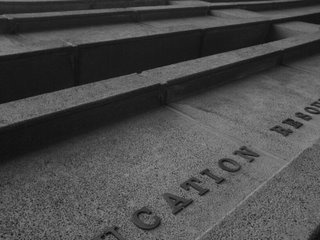 Inside and outside knowledge. Traditional. Traditions. History. What has traditionally stood as inside knowledge in education? Im not sure if a have a firm grasp on the context of the question, but i will answer as best i can. Inside knowledge is convention. The values and traditions that have underpinned education since its modern conception. Imagine what you assumed we would be teaching when we started this course. I guess in this sense inside knowledge was relevant to the world when its seeds were planted, today, one can even argue that inside knowledge is completely contextless, that outside the classroom it has no place.
Inside and outside knowledge. Traditional. Traditions. History. What has traditionally stood as inside knowledge in education? Im not sure if a have a firm grasp on the context of the question, but i will answer as best i can. Inside knowledge is convention. The values and traditions that have underpinned education since its modern conception. Imagine what you assumed we would be teaching when we started this course. I guess in this sense inside knowledge was relevant to the world when its seeds were planted, today, one can even argue that inside knowledge is completely contextless, that outside the classroom it has no place.Outside knowledge, is the knowledge that isnt taught in a classroom (traditionally). Its the knowledge one acquires from simply existing and interacting with others, be that their peer group, or parents and teachers. Outside knowledge, traditionally, has had no place in the classroom. The teacher doesnt care if you can answer every question ever asked about Def Jux Record Label. I believe the conflict between inside and outside knowledges have been at the heart of a lot of disengagement issues. I dont doubt that every teacher dreams of intergrating student interest and passion into their classroom, but the problem lies in the execution.
It is up to the teacher to bridge the gap between the traditional concept of inside knowledge and the students real interest in outside knowledge. Lets face it, these students have found their own meaning in these pursuits, be that music, graf, myspace, or drugs, who can blame them for resisting an older person feeding them nonsensical rubbish that they percieve as having no weight in their real world. Not that inside knowledge isnt valuble, however, as teachers we must realise that many of the elements that we have learnt by pursuing inside knowledge exist in beautiful and colourful forms in outside knowledge. The challenge lies in bridging the gap.
Urban Burnout
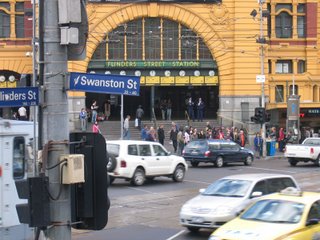 Learning takes place at all times. The lessons that we learn walking down the street are as valid as the lessons that we learn while we sit in classrooms. The difference is, while both are real, the classroom removes you from relevance. Being thrown in the midst of lifes lessons is something that all young people have to cope with, they learn the beautiful lessons, and the terrible lessons faster than they learn algebra, because their world relies on it.
Learning takes place at all times. The lessons that we learn walking down the street are as valid as the lessons that we learn while we sit in classrooms. The difference is, while both are real, the classroom removes you from relevance. Being thrown in the midst of lifes lessons is something that all young people have to cope with, they learn the beautiful lessons, and the terrible lessons faster than they learn algebra, because their world relies on it. It is because of this that i feel there couldnt be a better setting for Curriculum and assessment than an urban setting. At worse we have learnt you can "pad" out a double period or half a day, by taking students to the city, but at best, we learn that learning has no boundries. If we look at knowledge and learning as a spacial metaphor, then there are no boundries. You only need to look at different peoples opposing opinions, to realise that they learnt these opinions. If they are unfounded or unjustified, or plain wrong, it doesn't matter. My point is that there is nothing stopping the human mind seeking any knowledge it wants. What does stop it is outside influences.
Therefore, while in theory, knowledge, can be considered a salt lake, or the prairies in canada, flat, fenceless, limitless, a blank canvas, knowledge or learning has constraints and influences, it ebbs and flows like the pedestrians on the street, and the traffic after peak hour. The same can be said about curriculum and assessment, it is a historic and political affair. Therefore it comes with baggage, it comes with stories, some good, some terrible, it is not a freak of nature, nor is it beyond hope, or flawless, it is a construction of circumstance and oppurtunity and can be interpreted and utilised to achieve both damaging and amazing things.
The Urban Wheel
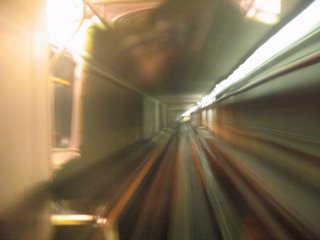 The past three weeks of teacher education have been the hardest of the year. I've always lived by the saying, the more you know, the more you realise you dont know. Standing outside the rhombus isnt as liberating as it sounds. Mental exploration can be a lonely pursuit, but i was reminded last tute that i have a team of good people who are watching my back. As a human being, I feel comfortable with the pack mentality. That said I guess we need each other to stay positive, and focused, so we dont get distracted by damaging influences.
The past three weeks of teacher education have been the hardest of the year. I've always lived by the saying, the more you know, the more you realise you dont know. Standing outside the rhombus isnt as liberating as it sounds. Mental exploration can be a lonely pursuit, but i was reminded last tute that i have a team of good people who are watching my back. As a human being, I feel comfortable with the pack mentality. That said I guess we need each other to stay positive, and focused, so we dont get distracted by damaging influences.As for my experiences the past three weeks... Its a really good question. I feel like new ideas are harder to digest, because I (and im sure this ring trues with all of you) am beginning to develop my own identity as a teacher. What i believe i have accessed, read, assessed, and analysed. If I can use it, ive made it fit, if i can't, ive let it slide, but used it to strengthen my own point of view.
The main thing i have learned, which is also my main cause for concern, is the amount of hard work it takes to be good at anything. Perhaps natural born anythings dont exist. Everything takes work. As for Teaching, i feel honoured to be working with the people ive met during the course, and im exited to be part of a unified front.
